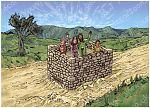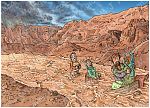Bible Cartoon: Luke 06 - Parable of the wise and foolish builders - Scene 03 - No foundations
Click on Add to cart button below shopping cart.
Purchased Bible Cartoons do not have watermarks. Links to Cartoons provided on email once purchase is completed.Bible Book: Luke
Bible Book Code: 4200604901
Scene no: 3 of 4
Bible Reference & Cartoon Description
Luke 6:49a (NLT)
49a But anyone who hears and doesn’t obey is like a person who builds a house without a foundation. [When the floods sweep down against that house, it will collapse into a heap of ruins.”]
DRAWING NOTES:
TIME OF DAY:
Unspecified by the Bible narrative; afternoon.
LIGHTING NOTES:
The sun (high in the sky on the left (West)) illuminates this scene, casting vague shadows to the right and below figures and objects.
CHARACTERS PRESENT:
A family: father (in grey), mother (in green), daughter (in green with pink parasol) and son (in rust brown) robes.
RESEARCH/ADDITIONAL NOTES:
The people in this picture are happily building their house on sand, without digging it away to lay any kind of foundation on solid rock. Notice the daughter is idly carrying a parasol; not even helping with the work!
I remember reading about the Lord God’s description of the Ostrich, in Job chp 39, careless of what happens to thier eggs [1] (see below, bold emphasis added), which reminded me of the carelessness of the people in this picture, and the people Jesus was talking to! The Ostriches are a visual representation of carelessness in my picture.
Notice the storm approaching in the background, from the left… rain is on the way!
Here is the scene without the figures, house or Ostriches in the foreground.

Background of Luke 06 – Parable of the wise and foolish builders – Scene 03 – No foundations
Click on the colour bar below to view/buy this Background:
Background of Luke 06 – Parable of the wise and foolish builders – Scene 03 – No foundations
[1]
Job 39:13-18 – New International Version
13 “The wings of the ostrich flap joyfully,
though they cannot compare
with the wings and feathers of the stork.
14 She lays her eggs on the ground
and lets them warm in the sand,
15 unmindful that a foot may crush them,
that some wild animal may trample them.
16 She treats her young harshly, as if they were not hers;
she cares not that her labour was in vain,
17 for God did not endow her with wisdom
or give her a share of good sense.
18 Yet when she spreads her feathers to run,
she laughs at horse and rider.
A note about the Ostrich.
The two flightless birds in my picture are Struthio camelus syriacus (the Arabian ostrich), also known as the Syrian ostrich or Middle Eastern ostrich, a subspecies of the Common Ostrich. In ancient Biblical times it was very common in the Arabian Peninsula, Syria, Iraq, and Israeli Negev. However, it became extinct around 1966.
Struthio camelus (The Common Ostrich), is a species of flightless bird native to certain areas of Africa. It is one of two extant species of ostriches, the only living members of the genus Struthio in the ratite [2] group of birds. The other is the Somali ostrich (Struthio molybdophanes), which has been recognized as a distinct species by BirdLife International since 2014, having been previously considered a distinctive subspecies of ostrich.
Of the two remaining, living species the Common Ostrich is the more widespread, and is the largest living bird species.
Ostriches have a distinctive appearance, with a long neck and legs, and can run for a long time at a speed of 34 mph (55 km/h) with short bursts up to about 60 mph (97 km/h), the fastest land speed of any bipedal animal and the second fastest of all land animals, after the cheetah. It lays the largest eggs of any living bird. Ostriches are the most dangerous birds on the planet for humans, with an average of two to three deaths being recorded each year in South Africa. When threatened, the ostrich will either hide itself by lying flat against the ground or run away, but if cornered, it can attack with a kick of its powerful legs.
The Common Ostrich is the tallest and heaviest living bird. Males stand 6 ft 11 in to 9 ft. (2.1 to 2.75 m) tall and weigh 220 to 290 lb (100 to 130 kg), whereas females are about 5 ft 9 in to 6 ft 3 in (1.75 to 1.9 m) tall and weigh 200 to 260 lb (90 to 120 kg). Their eyes are said to be the largest of any land vertebrate 2.0 in (50 mm) in diameter.
Ostrich eggs are the largest of all eggs, though they are actually the smallest eggs relative to the size of the adult bird – on average they are 5.9 in (15 cm) long, 5.1 in (13 cm) wide, and weigh 3.1 lb (1.4 kg), over 20 times the weight of a chicken’s egg. They are glossy cream-colored, with thick shells marked by small pits.
[2]
Ratites are a polyphyletic group consisting of all birds within the infraclass Palaeognathae that lack keels and cannot fly. They are mostly large, long-necked, and long-legged, the exception being the kiwi, which is also the only nocturnal extant ratite.





